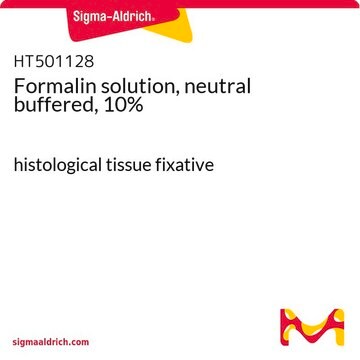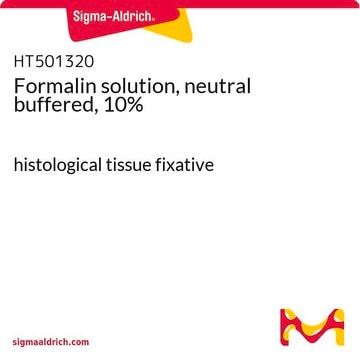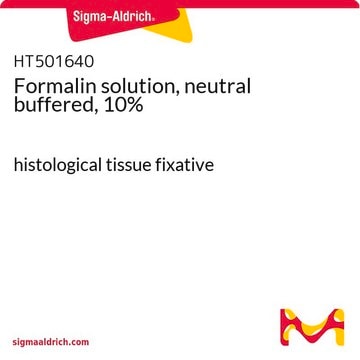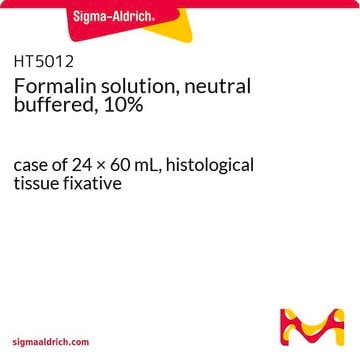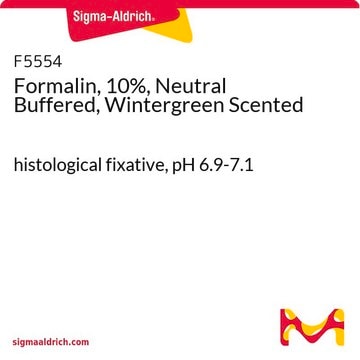The HT5011 solutions are advertised as 10% Neutral Buffered Formalin. The formaldehyde content, however, is expected to be in the range of 3.7% to roughly 4.0%. This can be rather confusing because the terms formaldehyde and formalin are often used interchangeably by some. For many histology laboratories, formaldehyde is used to describe formaldehyde content. Some laboratories do consider the terms interchangeable. Formalin is used to describe a dilution from the 37% to 40% stock bottle of the saturated solution. If the 37% to 40% solution is diluted 1 to 10, this is the origin of the term 10% formalin. But the formaldehyde content is still just 3.7% to 4.0%.
If a simple 2% solution of HT501 is desired, then simply dilute 1 part of HT501 with 4 parts of water. This would result in a formaldehyde content ranging from 0.74% to 0.8%. If you dilute with water, there is a chance the expiration dating could be affected. A better way to dilute 10% formalin would be to create a salt solution used for the original product. To prepare a suitable diluent for dilution, combine 4 grams of sodium phosphate monobasic and 6.5 grams of sodium phosphate, dibasic (anhydrous) in 1 liter of water. The water can be diluted in either distilled or deionized water. If 1 liter of diluent is not required, simply scale down in a proportional amount the amount of chemicals and water used. If the salts are used for dilution, it would probably be best to prepare a 2% solution and use it immediately. If a 2% formaldehyde solution is required, simply dilute the stock HT501 one to one with either water or the salt solution mentioned above. If using water, the same recommendation for immediate use is appropriate.
推薦產品
包裝
case of 48 × 15 mL
濃度
10% formalin (approx. 4% formaldehyde)
顏色
colorless
pH值
6.90-7.10
密度
1.080 g/cm3
應用
hematology
histology
儲存溫度
room temp
SMILES 字串
[O-]#[C+H2]
InChI
1S/CH2O/c1-2/h1H2
InChI 密鑰
WSFSSNUMVMOOMR-UHFFFAOYSA-N
尋找類似的產品? 前往 產品比較指南
一般說明
包裝
外觀
儲存和穩定性
訊號詞
Danger
危險分類
Acute Tox. 4 Inhalation - Acute Tox. 4 Oral - Carc. 1B - Muta. 2 - Skin Sens. 1
儲存類別代碼
6.1C - Combustible acute toxic Cat.3 / toxic compounds or compounds which causing chronic effects
水污染物質分類(WGK)
WGK 3
閃點(°F)
185.0 °F
閃點(°C)
85 °C
個人防護裝備
Faceshields, Gloves, Goggles, type ABEK (EN14387) respirator filter
客戶也查看了
-
How can a 10% buffered formalin solution be diluted to a 2% solution? Is it necessary to dilute it with buffered solution or can deionized water be used instead?
1 answer-
Helpful?
-
-
Is product HT5011 an IVD product? Is it 100% phosphate buffered?
1 answer-
HT5011 is not a product approved for IVD use. While the product was originally introduced as suitable for IVD use, the IVD status was changed to Research Use Only. The product currently carries a label for Research Use Only and is formulated with formaldehyde, water, and phosphate buffers.
However, there is a product that is approved for IVD use, which is available in package sizes of 700 mL, 5 L, and 10 L, with the product number 100496.
Helpful?
-
Active Filters
我們的科學家團隊在所有研究領域都有豐富的經驗,包括生命科學、材料科學、化學合成、色譜、分析等.
聯絡技術服務